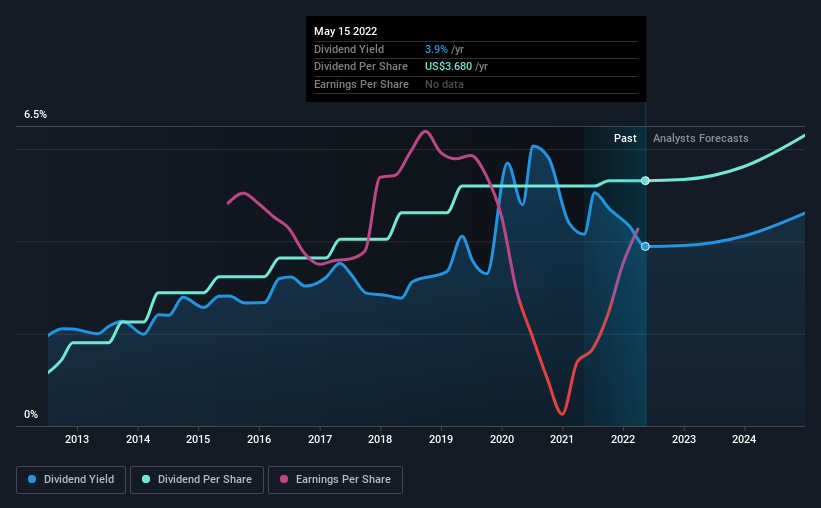Is It Smart To Buy Phillips 66 (NYSE:PSX) Before It Goes Ex-Dividend?
Regular readers will know that we love our dividends at Simply Wall St, which is why it's exciting to see Phillips 66 (NYSE:PSX) is about to trade ex-dividend in the next three days. The ex-dividend date occurs one day before the record date which is the day on which shareholders need to be on the company's books in order to receive a dividend. The ex-dividend date is an important date to be aware of as any purchase of the stock made on or after this date might mean a late settlement that doesn't show on the record date. Therefore, if you purchase Phillips 66's shares on or after the 20th of May, you won't be eligible to receive the dividend, when it is paid on the 1st of June.
The company's next dividend payment will be US$0.97 per share, on the back of last year when the company paid a total of US$3.68 to shareholders. Calculating the last year's worth of payments shows that Phillips 66 has a trailing yield of 3.9% on the current share price of $94.6. We love seeing companies pay a dividend, but it's also important to be sure that laying the golden eggs isn't going to kill our golden goose! As a result, readers should always check whether Phillips 66 has been able to grow its dividends, or if the dividend might be cut.
View our latest analysis for Phillips 66
Dividends are typically paid from company earnings. If a company pays more in dividends than it earned in profit, then the dividend could be unsustainable. Phillips 66 paid out 63% of its earnings to investors last year, a normal payout level for most businesses. That said, even highly profitable companies sometimes might not generate enough cash to pay the dividend, which is why we should always check if the dividend is covered by cash flow. Thankfully its dividend payments took up just 32% of the free cash flow it generated, which is a comfortable payout ratio.
It's positive to see that Phillips 66's dividend is covered by both profits and cash flow, since this is generally a sign that the dividend is sustainable, and a lower payout ratio usually suggests a greater margin of safety before the dividend gets cut.
Click here to see the company's payout ratio, plus analyst estimates of its future dividends.
Have Earnings And Dividends Been Growing?
Companies with consistently growing earnings per share generally make the best dividend stocks, as they usually find it easier to grow dividends per share. Investors love dividends, so if earnings fall and the dividend is reduced, expect a stock to be sold off heavily at the same time. Fortunately for readers, Phillips 66's earnings per share have been growing at 12% a year for the past five years. Phillips 66 has an average payout ratio which suggests a balance between growing earnings and rewarding shareholders. Given the quick rate of earnings per share growth and current level of payout, there may be a chance of further dividend increases in the future.
Many investors will assess a company's dividend performance by evaluating how much the dividend payments have changed over time. Phillips 66 has delivered an average of 16% per year annual increase in its dividend, based on the past 10 years of dividend payments. It's great to see earnings per share growing rapidly over several years, and dividends per share growing right along with it.
The Bottom Line
From a dividend perspective, should investors buy or avoid Phillips 66? We like Phillips 66's growing earnings per share and the fact that - while its payout ratio is around average - it paid out a lower percentage of its cash flow. Overall we think this is an attractive combination and worthy of further research.
With that in mind, a critical part of thorough stock research is being aware of any risks that stock currently faces. To that end, you should learn about the 3 warning signs we've spotted with Phillips 66 (including 1 which shouldn't be ignored).
If you're in the market for strong dividend payers, we recommend checking our selection of top dividend stocks.
Have feedback on this article? Concerned about the content? Get in touch with us directly. Alternatively, email editorial-team (at) simplywallst.com.
This article by Simply Wall St is general in nature. We provide commentary based on historical data and analyst forecasts only using an unbiased methodology and our articles are not intended to be financial advice. It does not constitute a recommendation to buy or sell any stock, and does not take account of your objectives, or your financial situation. We aim to bring you long-term focused analysis driven by fundamental data. Note that our analysis may not factor in the latest price-sensitive company announcements or qualitative material. Simply Wall St has no position in any stocks mentioned.

 Yahoo Finance
Yahoo Finance 
